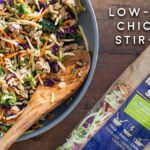Embark on a culinary journey designed to harmonize weight loss goals with the power of intermittent fasting. This collection of low-carb recipes isn’t just about shedding pounds; it’s about nourishing your body with delicious, satisfying meals that fuel your fast and optimize your eating window. Imagine vibrant colors bursting from plates piled high with nutrient-dense ingredients, aromas that tantalize the senses, and textures that delight the palate. This isn’t restrictive dieting; it’s a delicious exploration of mindful eating and sustainable weight management.
We’ll guide you through a curated selection of breakfast, lunch, dinner, and (where applicable) snack recipes, all meticulously crafted to support your intermittent fasting journey. Each recipe is detailed with step-by-step instructions, nutritional information, and vivid descriptions to help you visualize the final product. Learn how to adapt recipes to your dietary needs, and discover efficient meal-prep strategies to make this lifestyle both achievable and enjoyable.
Snack Recipes (if applicable within fasting window)

Snacking during an intermittent fasting window requires careful consideration. The goal is to choose foods that are both satisfying and won’t significantly impact blood sugar levels, potentially hindering the benefits of fasting. The following recipes offer delicious, low-carb options suitable for many intermittent fasting protocols, keeping you full and energized without breaking your fast. Remember to always consult your doctor or a registered dietitian before making significant dietary changes, especially if you have underlying health conditions.
Low-Carb Snack Recipe Options
The following three recipes provide diverse flavor profiles and nutritional benefits, all while remaining low in carbohydrates and suitable for consumption within a carefully planned intermittent fasting window. Portion sizes should be adjusted according to individual needs and fasting protocol.
Celery Sticks with Almond Butter
This simple snack combines the crisp crunch of celery with the creamy richness of almond butter, providing a satisfying blend of textures and healthy fats.
Ingredients: 4 celery stalks, 2 tablespoons almond butter.
Instructions:
- Wash and thoroughly dry the celery stalks.
- Cut the celery into 2-3 inch sticks.
- Spread approximately ½ tablespoon of almond butter onto each celery stick.
Avocado and Egg Salad
A protein-packed and creamy snack perfect for those needing a more substantial option. The avocado adds healthy fats and fiber, while the egg provides essential amino acids.
Ingredients: ½ avocado, 1 hard-boiled egg, ¼ teaspoon salt, ¼ teaspoon black pepper, 1 tablespoon olive oil (optional).
Instructions:
- Mash the avocado in a small bowl.
- Chop the hard-boiled egg finely and add it to the mashed avocado.
- Season with salt and pepper.
- Stir in olive oil, if desired, for added creaminess.
Macadamia Nuts and Cheese
This snack offers a satisfying blend of salty and fatty flavors, providing a good source of healthy fats and protein. The combination of textures creates a delightful eating experience.
Ingredients: ¼ cup macadamia nuts, 1 ounce cheddar cheese (or similar hard cheese).
Instructions:
- Choose your favorite hard cheese and cut or crumble it into small, bite-sized pieces.
- Combine the cheese pieces with the macadamia nuts in a small bowl.
Nutritional Comparison
The following table compares the calorie density and nutrient content of the three snack recipes. Note that these are approximate values and may vary based on specific ingredients and portion sizes.
| Recipe | Approximate Calories | Fat (grams) | Protein (grams) |
|---|---|---|---|
| Celery Sticks with Almond Butter | 150-200 | 15-20 | 3-5 |
| Avocado and Egg Salad | 250-300 | 20-25 | 8-10 |
| Macadamia Nuts and Cheese | 200-250 | 18-22 | 7-9 |
Mindful Snacking During Intermittent Fasting
Mindful snacking is crucial during intermittent fasting. These recipes help maintain satiety and prevent overeating during the eating window by providing a balance of healthy fats, protein, and fiber. Paying attention to hunger and fullness cues is vital; these snacks should complement, not derail, the overall fasting plan. Choosing nutrient-dense options, as demonstrated above, ensures you’re maximizing the benefits of your intermittent fasting approach while keeping energy levels stable and avoiding blood sugar spikes.
Mastering the art of low-carb intermittent fasting is a transformative experience, and this collection of recipes is your passport to success. By understanding the principles of macronutrient balance, mindful eating, and strategic meal planning, you’ll not only achieve your weight goals but also cultivate a healthier relationship with food. The journey is about more than just the numbers on the scale; it’s about feeling energized, vibrant, and empowered in your approach to health and wellness. The satisfying crunch of a perfectly prepared dish, the comforting aroma of spices, and the knowledge that you’re nourishing your body from the inside out – these are the rewards that await.
Key Questions Answered
What type of intermittent fasting is best suited for low-carb eating?
Various intermittent fasting methods work well with low-carb, including 16/8, 5:2, and alternate-day fasting. The best choice depends on individual preferences and lifestyle.
Can I still eat fruits on a low-carb intermittent fasting plan?
Fruit consumption should be limited due to its carbohydrate content. Berries are generally preferred in moderation due to their lower sugar content.
How do I manage hunger pangs during the fasting period?
Drink plenty of water, unsweetened tea, or black coffee. Focus on staying hydrated and keeping your mind occupied.
What are the potential side effects of low-carb intermittent fasting?
Potential side effects include headaches, fatigue, constipation, and “keto flu” initially. These usually subside as your body adapts. Consult your doctor before starting any new diet.


